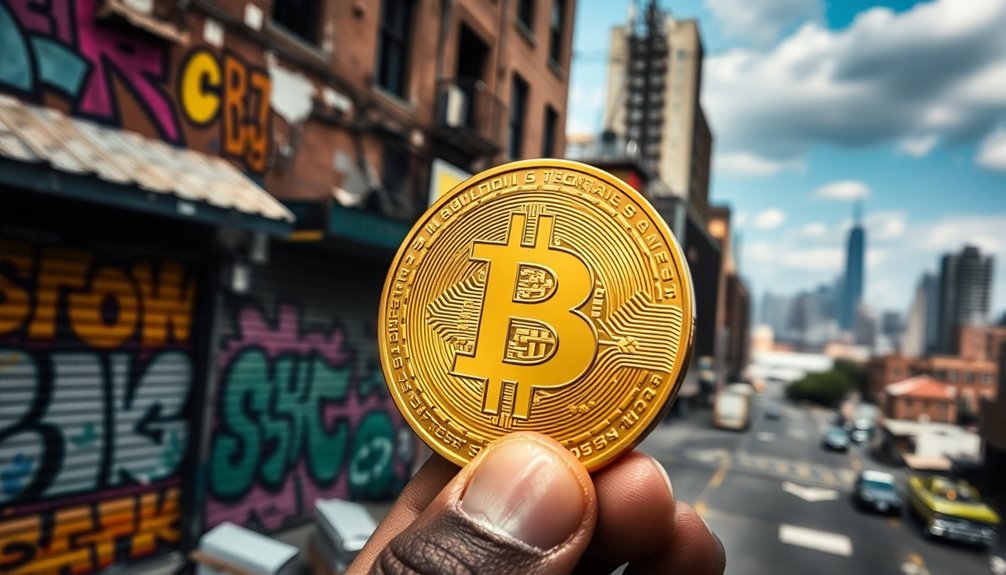America's loose economy is pushing Bitcoin to new heights, turning it into a stratospheric money machine. With interest rates cut and inflation concerns rising, you're seeing more investors flock to cryptocurrencies as a safe haven. Bitcoin's capped supply protects it from inflation, unlike traditional currencies that can be printed endlessly. Plus, upcoming regulations are boosting investor confidence. Statistically, younger demographics are driving this trend, which only adds to the excitement. As institutional interest grows, Bitcoin could exceed $200,000 by 2025. Curious about how this affects your investments? Stick around, and there's plenty more to uncover.
Key Takeaways
- The US Federal Reserve's interest rate cuts stimulate optimism in the cryptocurrency market, driving Bitcoin's price increase above $64,540 in September 2024.
- Economic instability and recession fears prompt investors to seek alternative assets like Bitcoin, enhancing its appeal as a hedge against inflation.
- The global cryptocurrency market is projected to grow significantly, indicating rising adoption and interest in Bitcoin as a legitimate investment.
- Recent regulatory advances, such as the MiCA Regulation in the EU, foster investor confidence, encouraging significant investments in the crypto market.
- Demographic shifts show younger, diverse investors increasingly favoring cryptocurrencies, indicating a growing trend toward Bitcoin ownership among Millennials and Gen Z.
Economic Recovery and Crypto Surge

In September 2024, the cryptocurrency market began to show signs of recovery following a tumultuous August. You might remember that August saw a massive downturn, with crypto markets losing $510 billion and Bitcoin dropping below $50,000. The fears of a recession, driven by disappointing employment data, sent stock prices plummeting, dragging down crypto values as well.
However, everything changed on September 18 when the US Federal Reserve announced an interest rate cut. This pivotal move propelled Bitcoin and Ether prices through critical resistance levels, allowing Bitcoin to end the month up 7.39%, just above $64,540.
As you observe this recovery, you'll notice that market sentiment shifted towards optimism, hinting at a potential bull cycle heading into Q4. The anticipation of Bitcoin's post-halving 'reaccumulation range' concluding in late September paved the way for a possible breakout in October. Additionally, analysts noted a potential transition to a bull cycle for Bitcoin, which ended September up 7.39%.
Furthermore, stablecoin valuations surged, especially for XRP, following the launch of Grayscale's XRP Token Trust. With institutional investors beginning to show renewed interest, you can see that the groundwork for a robust recovery in the cryptocurrency market is firmly being laid.
Regulatory Landscape and Market Impact

With the cryptocurrency market showing signs of recovery, attention turns to the regulatory landscape shaping its future. The upcoming MiCA Regulation in the EU is a significant development, set to harmonize regulations across member states and enhance investor protection. By focusing on Crypto-Asset Service Providers (CASPs) and stablecoins, it aims to foster market integrity while ensuring compliance with existing laws.
In countries like Brazil, new laws are legalizing cryptocurrencies as payment methods, while the U.S. classifies Bitcoin as a commodity, which influences how you might engage in trading or investing. Analysts predict that the conclusion of liquidations will lead to renewed market optimism and increased investor participation.
However, you should be cautious about jurisdictions like Colombia, where financial institutions can't facilitate Bitcoin transactions, or Chile, which lacks regulation. The impact of these regulations is twofold: they can increase market stability by establishing clear guidelines, but non-compliance might lead to hefty fines, adding costs for market participants.
Ultimately, supportive regulations boost investor confidence, encouraging more significant investments. As you navigate this evolving landscape, understanding these regulations will be essential for leveraging Bitcoin's potential in a complex economic environment.
Growth Projections for Cryptocurrency

The global cryptocurrency market is poised for substantial growth, projected to expand from a valuation of USD 1,643.77 million in 2022 to USD 2,740.93 million by 2030.
With a compound annual growth rate (CAGR) of 6.60%, this surge reflects rising adoption and rapid technological advancements. Economic fluctuations and financial instability are also fueling this expansion, making cryptocurrencies an attractive alternative for many. In particular, predictions suggest that Bitcoin could exceed $200,000 by 2025 as part of this growth trend.
As you explore this booming market, consider the emotional weight of these factors:
- Empowerment: You're part of a financial revolution, taking control of your investments.
- Opportunity: The potential for significant returns awaits those willing to plunge into.
- Community: Join a global network of like-minded individuals shaping the future of finance.
- Innovation: Witness the transformative power of blockchain technology as it evolves.
The bullish sentiment surrounding Bitcoin, with predictions of prices soaring, adds to the excitement.
As you navigate these dynamic waters, it's clear that the growth of cryptocurrency isn't just a numbers game—it's about reshaping how you think about wealth and investment in an increasingly uncertain world.
Demographic Shifts in Ownership

As the cryptocurrency market grows, understanding who's driving this trend is key. You'll notice that nearly 94% of crypto buyers are between the ages of 18 and 40, with Millennials making up a staggering 76.46%. This younger demographic is clearly leading the charge, while Baby Boomers and Gen X represent a mere fraction of the market.
Gender also plays a significant role, as about 65% of crypto owners identify as male. In fact, men aged 18 to 29 are far more likely to engage with cryptocurrencies than their female counterparts.
When it comes to race and ethnicity, the landscape is diverse. Black, Hispanic, and Asian Americans are more inclined to invest in cryptocurrencies compared to White Americans, indicating a shift in financial engagement across different communities. Notably, the Black male demographic shows significant interest in cryptocurrency, further emphasizing this trend.
Education and income further influence ownership. Crypto owners often hold higher degrees and earn more than the general population, with wealthier individuals more likely to invest in cryptocurrency.
On the flip side, lower-income users often turn to crypto for everyday transactions. Understanding these demographic shifts gives you insight into who's shaping the future of cryptocurrency.
Bitcoin as an Inflation Hedge

While many investors seek refuge from inflation in traditional assets, Bitcoin has emerged as a compelling alternative. Its capped supply of 21 million coins and decreasing inflation rate make it uniquely positioned as a shield against economic uncertainty.
Unlike traditional currencies that can be printed at will, Bitcoin's scarcity is a game changer, giving you a sense of security in your investments. Bitcoin's fixed supply capped at 21 million BTC ensures that it cannot be devalued through excessive issuance. Additionally, the diversification of retirement portfolio is crucial for mitigating risks associated with economic volatility.
Consider the following reasons why Bitcoin stands out:
- Limited Supply: Only 21 million Bitcoins will ever exist, creating a digital gold-like scarcity.
- Price Surge: Historical data shows Bitcoin prices often rise sharply after high inflation reports, reflecting its safe-haven status.
- Institutional Confidence: Growing institutional interest in Bitcoin signals its acceptance as a legitimate store of value.
- Economic Policy Influence: Favorable regulations and concerns about fiat currency devaluation boost Bitcoin's appeal.
As inflation expectations rise, Bitcoin's prices tend to climb, reinforcing its role as an inflation hedge.
With more investors recognizing its potential, Bitcoin not only offers a refuge but also a chance to thrive in uncertain economic times.
Frequently Asked Questions
How Does Bitcoin Mining Impact the Environment and Energy Consumption?
Bitcoin mining greatly impacts the environment and energy consumption. It consumes around 0.5% of global energy, using more electricity than the entire country of Argentina annually.
You should also consider that each Bitcoin transaction requires about 16,000 liters of water, contributing to local shortages, especially in arid regions.
Additionally, it generates a substantial amount of electronic waste, posing risks to the environment through toxic materials and improper recycling practices.
What Security Measures Should Investors Take When Buying Bitcoin?
In a world where digital treasures can vanish like smoke, you must take security seriously when buying Bitcoin.
Start by using multi-sig wallets for added protection, and store a portion offline in cold storage.
Implement strong passwords, enable two-factor authentication, and keep your software updated.
Stay vigilant by monitoring your accounts regularly and diversifying your investments.
How Can Someone Start Investing in Bitcoin Today?
To start investing in Bitcoin today, first, set up a digital wallet to securely store your assets.
Next, choose a reliable trading platform with a user-friendly interface and strong security measures.
Once you've funded your account, consider your investment strategy—whether it's HODLing or dollar-cost averaging.
Always stay informed about market trends and manage your risks carefully, as Bitcoin's volatility can impact your investment greatly.
Happy investing!
What Are the Risks Associated With Investing in Cryptocurrencies?
Investing in cryptocurrencies can feel like riding a roller coaster—thrilling yet unpredictable.
You've got market risks with wild price swings that can drain your wallet overnight. Information risks lurk in the shadows, hiding unreliable data and technical jargon.
Then there's acceptance and regulatory risk; not everyone's on board with crypto.
Finally, remember the threat of fraud and theft, where cybercriminals wait to snatch up your investments.
Stay sharp and informed!
How Does Bitcoin Compare to Traditional Investments Like Stocks or Bonds?
When you compare Bitcoin to traditional investments like stocks or bonds, you'll notice significant differences in performance and risk.
Bitcoin often provides higher long-term returns, like a 10-year CAGR of +74%, versus the S&P 500's +11%.
However, it comes with higher volatility, which can lead to sharp price swings.
While Bitcoin can diversify your portfolio, its correlation with traditional assets can change based on economic conditions, making it essential to take into account your risk tolerance.
Conclusion
As you watch the world around you shift, it's hard not to feel the pulse of change. The economy's loose grip on stability is pushing more people toward Bitcoin, making you wonder—what's next? Will it be a lifeline or a ticking time bomb? As digital currencies surge and demographics evolve, the stakes have never been higher. Are you ready to embrace this bold new frontier, or will you let the tide of opportunity sweep past you?










